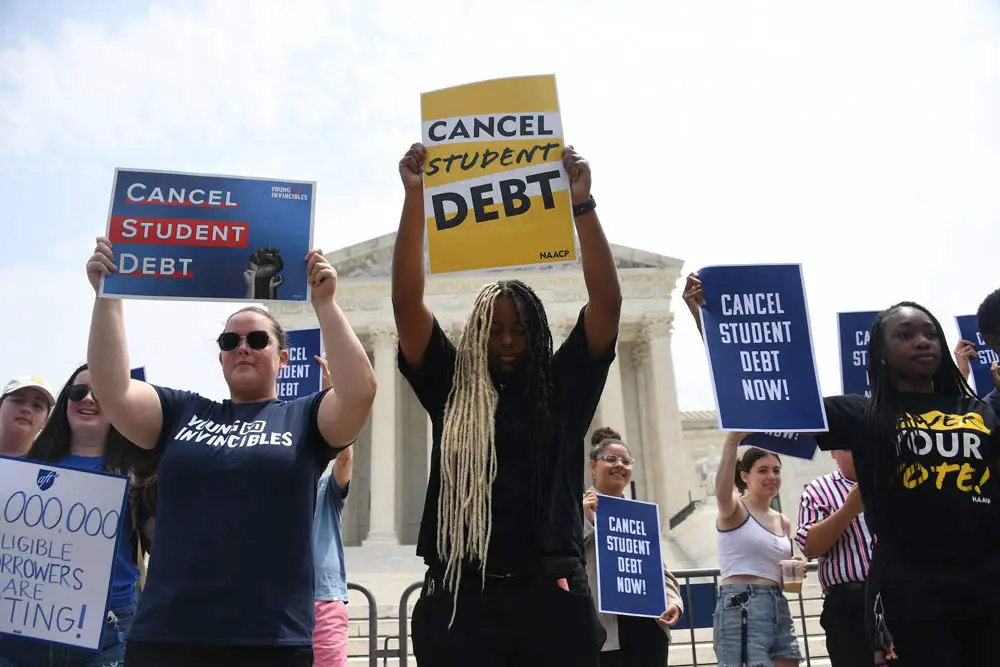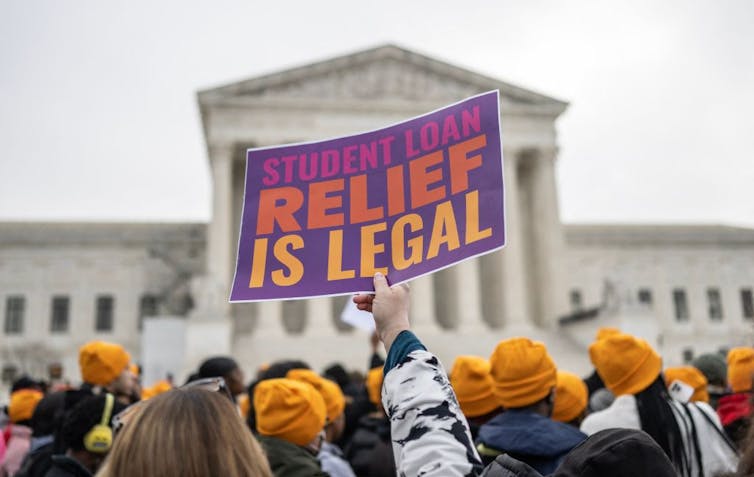
By William Chittenden
The Supreme Court has struck down the Biden administration’s student loan forgiveness plan. In Biden v. Nebraska, the court ruled 6-3 on June 30, 2023, that the secretary of education does not have the authority to forgive US$430 billion of student loans under the Health and Economic Recovery Omnibus Emergency Solutions Act.
That kills the president’s proposed plan to forgive up to $10,000 in student loans per borrower for those with incomes under $125,000 per year, or $250,000 per year for couples. Under the president’s plan, those who received Pell Grants would have been eligible to cancel up to an additional $10,000 in student loans.
Just hours after the decision, President Biden announced a new effort to forgive student loans under the Higher Education Act of 1965.
To give borrowers time to “get back up and running,” Biden stated that the Education Department won’t refer borrowers who don’t pay their student loan bills to credit agencies for 12 months.
Secretary lacks authority
In the majority opinion, Chief Justice John Roberts – joined by his five other conservative colleagues – stated “The HEROES Act allows the Secretary to ‘waive or modify’ existing … financial assistance programs under the Education Act, but does not allow the Secretary to rewrite that statute to the extent of canceling $430 billion of student loan principal.”
Currently, over 43 million Americans owe $1.64 trillion in federal student loans, with an average balance of $46,000. Student loan borrowers haven’t had to make payments on their federal loans – or accrue interest on those loans – since March 2020, when the Trump administration put the payments on pause due to the COVID-19 pandemic.

Andrew Caballero-Reynolds/AFP via Getty Images
But that will change on Sept. 1, 2023, when interest will once again begin to accrue on outstanding student loans. Payments on the actual loans is set to resume in October 2023.
When payments resume, the average student loan payment is expected to be between $200 and $500 per month. For those that resume making their federal student loan payments on time, this may lead to an increase in their credit score, while those that miss the first payment after payments resume can expect their credit score to fall.
Prior to the student loan pause, approximately 7.5 million borrowers – out of 43 million – were in default on their federal student loans.
These borrowers can apply for the Fresh Start program. For borrowers who are behind on their federal student loan payments, this program allows student loan borrowers to reset their loan so they won’t be considered past due anymore.
In addition, any negative entries on their credit report due to being behind on their student loans will be removed. About 80% of Fresh Start borrowers enroll in an income-driven repayment plan. Such a plan calculates a borrower’s monthly federal student loan payment based on the borrower’s income, spouse’s income and family size. Monthly payments under this plan will not exceed 20% of the borrower’s income. Those with larger families and lower incomes have lower monthly payments. Currently, about half of the Fresh Start borrowers pay $0 a month.
It is estimated that student loan borrowers pay about $70 billion a year on their federal student loans. Any economic benefit that borrowers may have gotten from the suspension of student loan payments is likely to have already been absorbed into the economy over the past three years. In other words, any money borrowers had to spend as a result of the student loan pause has already been spent.
With the resumption of student loan payments, there will likely be a small but negative impact on the economy. This reduction in spending on goods and services is estimated to reduce economic growth by about 0.4%
When student loan borrowers begin to repay their loans in October, those dollars will no longer be available to pay for other things like food, rent, clothing or gas. So it won’t only hurt the economy, but it will hurt people, too.
William Chittenden, Associate Professor of Finance, Texas State University
This article is republished from The Conversation under a Creative Commons license. Read the original article.
![]()
William Chittenden is Associate Professor of Finance at Texas State University.





























Jimbo99 says
Too many rely on student loan debt for a career & income, it’s a billion/trillion dollar industry that can’t afford to write off that debt for the masses. Those that are in debt over college degrees they never received as dropouts or whatever else is the reason they never accomplished that educational achievement, would soon be in debt for housing, automobiles & anything else. Biden inflation would become more rampant. It went up, because there were those that had $ 200+ month more to spend with what student Loan Debt forgiveness that did happen. The cycle would simply start over for them.
Dennis says
Let’s get to the real point! Biden did not have the authority to do so. He was told that by democrats up front. He put false hope in the hearts of kids. Now he’s trying to do it again.
Ban the GOP says
Funny how people had no issue with bailing out banks, automobiles, airlines or whatever corporate entity needs some money but to help actual humans thats just woke. Hell they could have forgiven the loans for less than the corporate fraud committed with PPP loans. Maybe back in your day the whole borrow loans and work was feasible but today its just a poverty trap. These kids will never repay that money with current wages so keep racking that interest till they default and then policticans will bail out the loan providers without question for 10 times the money. Genius.
Ban the GOP says
Ha so we gave 100 plus billion to three poorly run banks but helping young people not financially drown should not be considered….says the Republicans
Jessup says
Don’t take responsibility for yourself. What is mine is mine and what is yours is mine…… says the Democrats. It was all a lie from the beginning. It was all to pull in votes from the gullible idiots.
Ban the GOP says
We live in a country where Repblicans gave 3 trillion dollars in tax breaks to the richest of people and ultimately cut food assistance programs for the impoverished to pay for it. With your mentality lets cut social security and medicare and medicaid then it be like a real free for all. Oldies can to get back to work and end all the social welfare they get. Its their fault if they didnt save enough right? The bank CEOs took responsibility by giving themselves bonuses before the government funded bailout so where is their “responsibility” ? Seems like you should read some banned books or watch something other than propaganda tv.
Land of no turn signals says says
Why in HELL should taxpayers pay for other people’s debt.Why not pay off there car’s and Suv’s that they can’t afford and while were at it let’s pay off everybody’s mortgage.What a bunch of snowflakes.
Bob J says
I’m at a loss for words. This should not be happening. When I graduated, Loan payments started. Pay your way as I did. When these students got the loans, they signed a contract to repay the loan. Suck it up. Welcome to the real world.
Atwp says
What will the Government do when another bank fail? They will bail the bank out. The weak Republicans will love it.
Pogo says
@Equal time to fight the slime